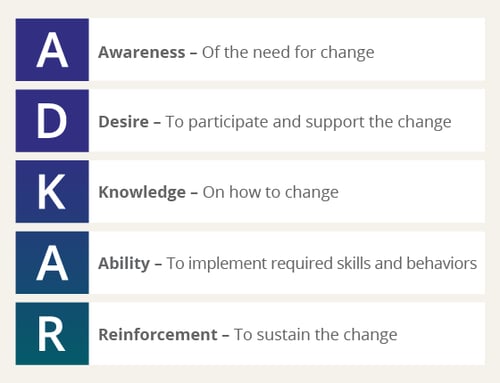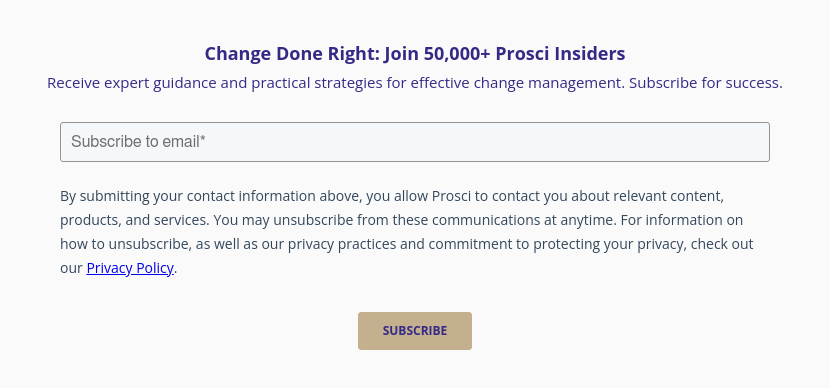Challenges You May Encounter in Building A, D, K, A and R

4 Mins
Updated: August 20, 2025
Published: June 1, 2015

The Prosci ADKAR Model is one of the most requested change management models in the world. However, building Awareness, Desire, Knowledge, Ability and Reinforcement is not always easy. Understanding common challenges and supporting data will help you address issues and barriers you may face when applying the ADKAR Model.
What is the Prosci ADKAR Model?
The Prosci ADKAR® Model is a model for individual change, which describes how one person successfully transitions through a change. By breaking down successful change into five simple steps, change management practitioners are able to make sense of individual transitions and support people in ways that lead to more successful project outcomes.
The ADKAR Model presents the five elements of successful change as:

Whether the change is at home, in the community, or in the workplace, an individual can succeed at change when he or she can say, "I have Awareness, Desire, Knowledge, Ability and Reinforcement." Change management practitioners use the ADKAR Model to guide change management plans and activities. Because it is results-oriented and focused on the individual, ADKAR has the ability to unlock organizational change efforts.
Building the necessary Awareness, Desire, Knowledge, Ability and Reinforcement is essential in creating successful change, but it is not always easy. If an individual is experiencing a change but does not possess each of the ADKAR elements, the change will struggle and stall. In this way, The ADKAR Model can be used as an effective diagnostic tool that focuses on the root cause of why change is not occurring.
What challenges might you face as your work to build A, D, K, A and R?

ADKAR Challenges
During a Prosci webinar, attendees were asked which ADKAR element—or building block of success—they thought posed the biggest challenge. Although Desire was by far the most challenging element cited, each has its own unique challenges.
Why Awareness can be challenging
Only 9% of webinar attendees identified Awareness as posing the biggest challenge. However, when asked about why employees and managers resist change, studies have identified a "lack of awareness" as the top reason for resistance. This is an interesting disconnect. One of the primary reasons for this disconnect—that Awareness is not perceived as a challenge when it is the top reason for resistance—is that building Awareness is often overlooked.
Without the grounding and orientation ADKAR provides, it is easy to focus on the "what" and ignore the "why" in times of change. Communication messages that center on project details and vision are an example of overlooking Awareness. To enable employees to embrace, adopt and use a change resulting from a project or initiative, you must first answer "why" the change is necessary.
Why Desire can be challenging
Over two-thirds of webinar attendees (69%) identified Desire as posing the biggest challenge. The reason Desire is routinely identified as the biggest challenge is that it is ultimately a personal decision to get on board and support a change. While this decision can be influenced, no one can make an individual have the Desire to support the change.
Because Desire is a personal choice, it is the most difficult of the five ADKAR elements to create. However, change management practitioners are not helpless. By highlighting the personal and organizational motivators for the change, and by leveraging the support of senior leaders, managers and supervisors, employee Desire can be created.
Why Knowledge can be challenging
The fewest webinar attendees (2%) identified Knowledge as posing the biggest challenge. Many organizations have experience and competencies in building Knowledge in their training and learning departments. The challenge associated with Knowledge comes from the propensity of project teams to default to Knowledge. In times of change, the immediate response is "send the employees to training."
Training, without the prerequisite Awareness and Desire, will not be effective. Change management practitioners can ensure that sufficient Awareness and Desire exist before jumping to Knowledge and can support project teams in identifying the Knowledge needed both during and after the change.
Why Ability can be challenging
Ability was the second least identified challenge (5%). Again, this stems from organizations' existing experience and competency in supporting skill development. The challenge with Ability results from the need to foster Ability through practice. Many organizational changes are occurring so quickly that employees do not have the capacity or time to turn their Knowledge into Ability.
If there is a potential Ability gap on a project, it is important to intentionally create the time necessary to foster It. Change management practitioners are also uniquely positioned to identify and resolve barriers to Ability.
Why Reinforcement can be challenging
Reinforcement was identified as the second biggest challenge by webinar attendees (15%). The primary challenge related to Reinforcement is that it takes time and energy. In many of today's organizations, there are so many change efforts underway that there simply isn't the time and energy to spend on reinforcing a change.
In addition, Reinforcement activities are often not considered during the planning phase of a project. Because Reinforcement activities occur after a project passes the go-live stage, the project team has typically moved on to the next project. With no one in particular having the responsibility to ensure that the last project was fully implemented, Reinforcement can be neglected. The pace of change and change saturation make Reinforcement an afterthought.
Tips for Addressing ADKAR Challenges
-
Look at change through an ADKAR lens
By addressing individual change with a structured model defining success, you will be more effective in sequencing your work and how you engage employees. -
Understand the driving and restraining forces of each ADKAR element
Kurt Lewin introduced his notion of force field analysis, including driving and restraining forces, in his seminal work regarding social psychology. These forces apply to ADKAR as well. For example, there are driving forces on Awareness and restraining forces on Awareness. If you understand these forces, you will be able to influence them to move a change forward. -
Use the right tools to build each ADKAR element
You cannot train Awareness, and you cannot communicate Knowledge. With ADKAR as your framework, you will be more equipped to use the right tools at the right times when managing the people side of change. -
Remember, ADKAR is a model for individual change
Although we can talk about patterns related to ADKAR, in the end it is an individual who experiences change and the challenges they face will be individual. This is why leading organizations are teaching their people to apply the Prosci ADKAR Model: so they can be more effective in one-on-one interactions with their employees.
The ADKAR Advantage
The ADKAR Model is widely used in organizations around the globe to support people through changes of all kinds—from ERP systems implementation and post-merger integration to digital transformation and AI adoption. To learn more about our ADKAR Model and its many applications, explore our website for a variety of free downloads, webinars and other informative resources designed to help you and your organization grow stronger from change.



